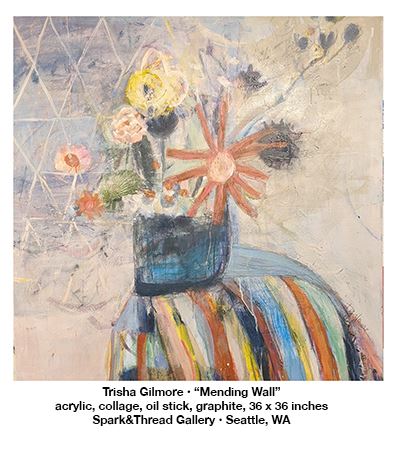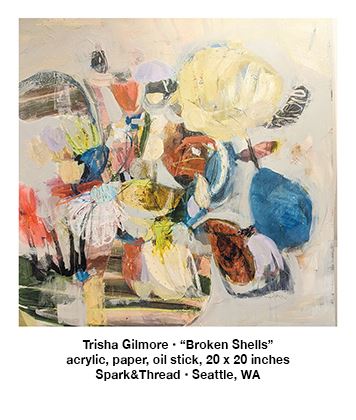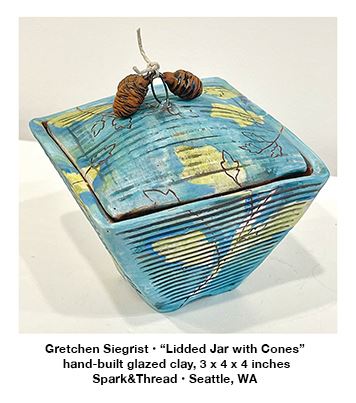 Spark&Thread is a women-owned art boutique in the Capitol Hill/Stevens neighborhood. Established in late 2021, the shop features locally-made creations for the home, and it showcases the work of the owners/artists Juli Hudson and Solia Hermes.
Spark&Thread is a women-owned art boutique in the Capitol Hill/Stevens neighborhood. Established in late 2021, the shop features locally-made creations for the home, and it showcases the work of the owners/artists Juli Hudson and Solia Hermes.
 Central to Hudson’s and Hermes’ vision for Spark&Thread is to represent other local artists and craftspeople, and to connect to the surrounding arts community — Hermes calls the shop itself “a living arts space.”
Central to Hudson’s and Hermes’ vision for Spark&Thread is to represent other local artists and craftspeople, and to connect to the surrounding arts community — Hermes calls the shop itself “a living arts space.”
March 8 through April 30, Spark&Thread is spotlighting the work of painter Trisha Gilmore and ceramist Gretchen Siegrist.
Trisha Gilmore is a Seattle-based artist who has taught art in and out of the classroom with Pratt, Powerful Schools, Seattle Public Schools, The Community School, and other venues. She works most frequently with acrylic paint on a square or close-to-square canvas. Gilmore likes to complement her acrylics with traces of ink or graphite, and she applies swatches of vintage paper or other material to the paintings. The collage material is directly on the surface in some pieces, but subtly so, while in other works the collage material is painted over, and left to make its presence known only as a ghostly shape or a faint texture just below the surface.
Gilmore is drawn to natural forms —f lowers and plants, in particular. Frequently she depicts the flowers arranged in vases set on tables or countertops that anchor the composition. You might be thinking still-life, but visually there’s little stillness — in fact the work hums with happy activity. The colors are sometimes muted, but the organic shapes are plentiful and rendered loosely and playfully. Freeform marks, drips and smears, and the vague trace of forms painted over contribute to this mood of contented restlessness.
 Even as Gilmore plays with floral themes and designs she strongly embraces abstraction; she paints and draws intuitively and imaginatively. Figure and ground are in a dervish dance in many of her pieces, and things that are solid seem to melt into air. In “Mending Wall” the vertical stripes of the tablecloth make an assertive and colorful foreground, but the neutrally-colored flowers and bulbs that are the painting’s focus tend to blend or incorporate into the background — the wall itself.
Even as Gilmore plays with floral themes and designs she strongly embraces abstraction; she paints and draws intuitively and imaginatively. Figure and ground are in a dervish dance in many of her pieces, and things that are solid seem to melt into air. In “Mending Wall” the vertical stripes of the tablecloth make an assertive and colorful foreground, but the neutrally-colored flowers and bulbs that are the painting’s focus tend to blend or incorporate into the background — the wall itself.
Although even here we face ambiguity — a solid mass of color in the background on one side of the canvas is balanced against
the other side’s depiction of airy lattice-work (a support for plants to cling to as they climb up from the ground). Perhaps inspired by Robert Frost’s famous poem of the same name, “Mending Wall” seems to reflect on the nature of walls, and “What I was walling in or walling out.”
The botanical theme in Gilmore’s work is echoed in the clay creations of Gretchen Siegrist, a Resident Artist at Seward Park Clay Studio. Her painted clay surfaces often depict sprigs and leafs and flower petals. The pieces in her delightful “Houses” series you can think of as birdhouses or simply tiny houses (but really tiny, many standing tall at 10 inches at the most) but in each dwelling fun overrules function – the house shapes themselves are skewed, fanciful rather than practical, and not many creatures could get in through their sliver-thin door openings.
 In Siegrist’s cups and in her other containers (planters, bowls, birdbaths), we see a shift towards actual function (as you would expect) and a shift in tone within their visual vocabulary—less whimsical than the houses, more considered and closely observed. Rather than the simplified and isolated flower outlines or line drawings, we find intricate imagery and more “scenes” — birds and ferns, pine cones and seed pods, a stand of fir trees. One piece illustrates new growth sprouting from a nurse-log, an image that reflects the artist’s interest in natural decomposition — Siegrist even builds pieces from clay remnants, a way of embodying the life-cycle concept within her materials and processes.
In Siegrist’s cups and in her other containers (planters, bowls, birdbaths), we see a shift towards actual function (as you would expect) and a shift in tone within their visual vocabulary—less whimsical than the houses, more considered and closely observed. Rather than the simplified and isolated flower outlines or line drawings, we find intricate imagery and more “scenes” — birds and ferns, pine cones and seed pods, a stand of fir trees. One piece illustrates new growth sprouting from a nurse-log, an image that reflects the artist’s interest in natural decomposition — Siegrist even builds pieces from clay remnants, a way of embodying the life-cycle concept within her materials and processes.
It’s not only color glazes on the surface that paint pictures.
Siegrist also shapes the clay to create her small organic forms. She’ll make birds that perch on the lip of a cup, or a fig branch with detailed fig fruit. The thick rim of a birdbath is incised and shaped so that it looks convincingly like rugged bark, complete with wormholes and other signs of life and decomposition.
But not every piece is a celebration of nature. On occasion, her work bears handwritten expressions, and playful shapes—swoops and swirls—are always a possibility. In one piece she impresses the shape of musical notes into the clay, where they dance around impressions of Spanish-style guitars.
Nor does Siegrist limit herself strictly to clay. Many of the sculptural pieces involve wood, rope, string, and wire, either for decorative or functional purpose, or a bit of both at once.
 Siegrist seems to share that community-based vision that inspires the co-owners of Spark&Thread. She puts effort toward supply drives for her unhoused neighbors, for example.
Siegrist seems to share that community-based vision that inspires the co-owners of Spark&Thread. She puts effort toward supply drives for her unhoused neighbors, for example.
Her work may be light in spirit but in her art-making and in her life she is pushing back against “an upside-down, industrialized world” (to quote from Siegrist’s website).
Tom McDonald
Tom McDonald is a writer and musician living on Bainbridge Island, Washington.
Artwork by Trisha Gilmore and ceramist Gretchen Siegrist is on view March 8th through April 30th, Wednesday through Saturday from 11 A.M. to 6 P.M. and Sunday from noon to 5 P.M. at Spark&Thread, located at 1909 E. Aloha Street in Seattle, Washington. All are welcome to come to the Artists’ Reception on Friday, March 17, 5-9 P.M. For information, visit www.sparkandthread.store.